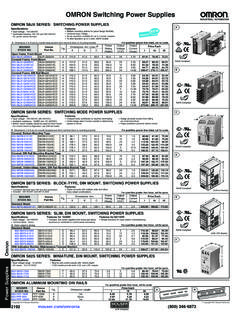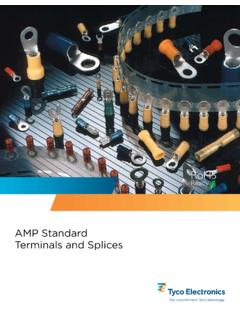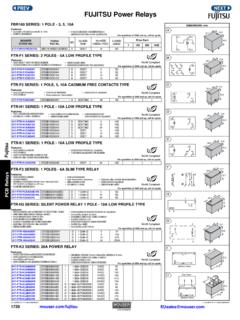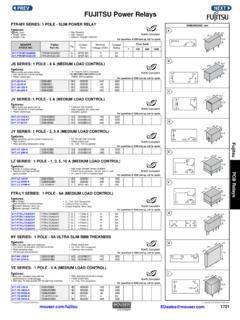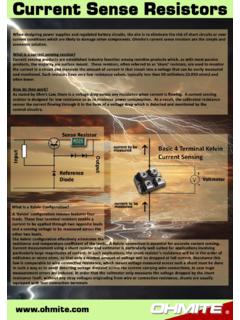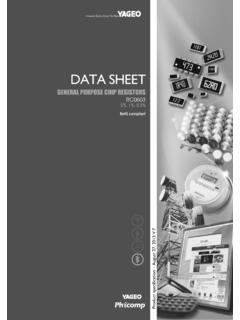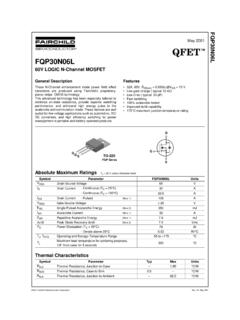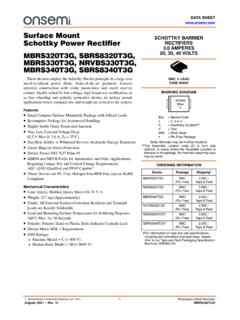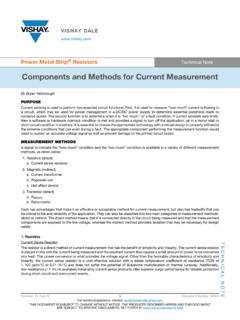Transcription of Power MOSFET Basics - Understanding Voltage Ratings
1 VISHAY SILICONIX. mosfets Application Note AN851. Power MOSFET Basics - Understanding Voltage Ratings By Sanjay Havanur DESCRIPTION. Two kinds of Voltage Ratings are provided for mosfets in their datasheets - VDS and VGS. For each, both absolute maximum and rated voltages are specified. Usually, the numbers are the same, but manufacturers use them in different contexts and for different purposes. By definition, absolute maximum Ratings specify the limits for long term reliability and / or survival. Rated values are used for characterizing the device and act as reference values at which other measurements are taken.
2 Most qualification tests are done at the rated voltages or at a specified percentage thereof. For example, leakage currents from drain to source or gate to source are measured and specified at rated voltages, both at normal ambient as well as at elevated temperatures. Qualification tests such as High Temperature Reverse Bias (HTRB) or High Temperature Gate Bias (HTBG) are performed at 80 % of the rated Voltage . In this context, it may be useful to compare rated vs. absolute maximum voltages for integrated circuits and discrete devices. For ICs there is a recommended range of applied voltages within which performance is guaranteed.
3 These limits are set by internal circuitry and bias conditions. In addition, absolute maximum limits are also provided, and these are invariably higher than the recommended or operating maximum Voltage values. In the case of ICs, these are defined by the process, and exceeding them may permanently damage the device. By contrast, there is no operating range of voltages for mosfets ; they can be operated at any Voltage from zero up to and including rated Voltage . However, since the absolute values are the same as rated values, it is important not to exceed either of the limits under all operating conditions.
4 OVERVOLTAGE INDUCED FAILURES. Intentionally or otherwise, a MOSFET might be subjected to higher voltages during operation which could lead to its destruction. There are different ways an overvoltage can occur and different mechanisms by which a device can fail. Figures 1a and 1b show the cross section of a typical trench MOSFET and its equivalent electrical circuit. Of particular interest are the junctions where the body diode and the parasitic bipolar junction transistor (BJT) are formed. The reverse diode is a result of P+ body diffusion into the N epi, and the BJT is formed when the N+ source contact is diffused on top.
5 It should be remembered that the schematic is only a lumped representation. Circuit elements such as resistors, capacitors, or the body diode are distributed over the entire map. Also, a typical MOSFET may consist of millions of cells, all operating in parallel but not equal in all respects. The survival of the device as a whole under extreme conditions is determined by the weakest of those millions of cells. Drain Source Contact Gate Gate CDG Body N+ N+ N+ N+ CDS. APPLICATION NOTE. Trench Trench Diode RB. P + Body Parasitic Rg BJT. Parasitic Body BJT. E Field under RB.
6 Diode CDS. N - epi CGS. reverse bias Source N + Substrate --- Displacent Current due to dV/dt /. --- avalanche and Irr Current paths Fig. 1a - Cross Section of a Trench MOSFET Fig. 1b - Equivalent Circuit Revision: 12-Jan-17 1 Document Number: 75079. For technical questions, contact: THIS DOCUMENT IS SUBJECT TO CHANGE WITHOUT NOTICE. THE PRODUCTS DESCRIBED HEREIN AND THIS DOCUMENT. ARE SUBJECT TO SPECIFIC DISCLAIMERS, SET FORTH AT Application Note AN851. Vishay Siliconix Power MOSFET Basics - Understanding Voltage Ratings When a reverse bias is applied between drain and source, an electric field is set up across the P-N junction.
7 When the applied Voltage increases beyond the rating, a critical field is reached where the junction can no longer support the applied Voltage . Impact ionization intensifies rapidly, leading to avalanche multiplication of carriers. The resulting reverse current tends to flow laterally in the P body, as shown in Figure 1a, since the electric field is the strongest at the point where the junction bends along the gate trench contour. The current is represented by the dashed red line in the schematic of Figure 1b. The subsequent failure may happen due to excessive heat in the die, or due to parasitic bipolar latch-up.
8 When the Voltage drop across RB is sufficient to forward bias the parasitic BJT, it will turn on, leading to catastrophic failure. There have been many advances in MOSFET . design technology targeted at minimizing the base resistance RB to prevent the bipolar turn-on. However, no MOSFET is totally immune to latch-up. Junction temperature plays an important role in triggering the failure. Silicon resistivity increases with temperature, and the forward bias threshold of the base emitter junction reduces at the same time. The combination of higher RB and a lower threshold results in bipolar turn-on at much lower currents.
9 Paradoxically, the critical field value at which avalanche breakdown is initiated also increases with temperature. At higher values of junction temperature TJ, the device can support greater values of VDS across the P-N junction before the temperature-specific critical field is reached. Typically, this is reflected in the rated Voltage specifications of high Voltage mosfets (HVMs). A 600 V MOSFET at TJ = 25 C has a 650 V or higher rating at TJ = 150 C. However, the improved rating is not of much benefit to the user as it is relevant only in steady state where VDS is gradually increased.
10 In all practical applications, the high VDS is accompanied by large drain currents, which lead to bipolar latch-up. One common application condition where the MOSFET will see voltages well above the rated VDS is under unclamped inductive switching (UIS). The standard UIS circuit and simplified waveforms are shown in Figures 2a and 2b. Though overvoltage and avalanche breakdown are evident, it should be noted that the UIS is a current-driven, transient event. The avalanche current in this case is the same as the peak inductor current indicated by the red dashed line in Figure 1b.
